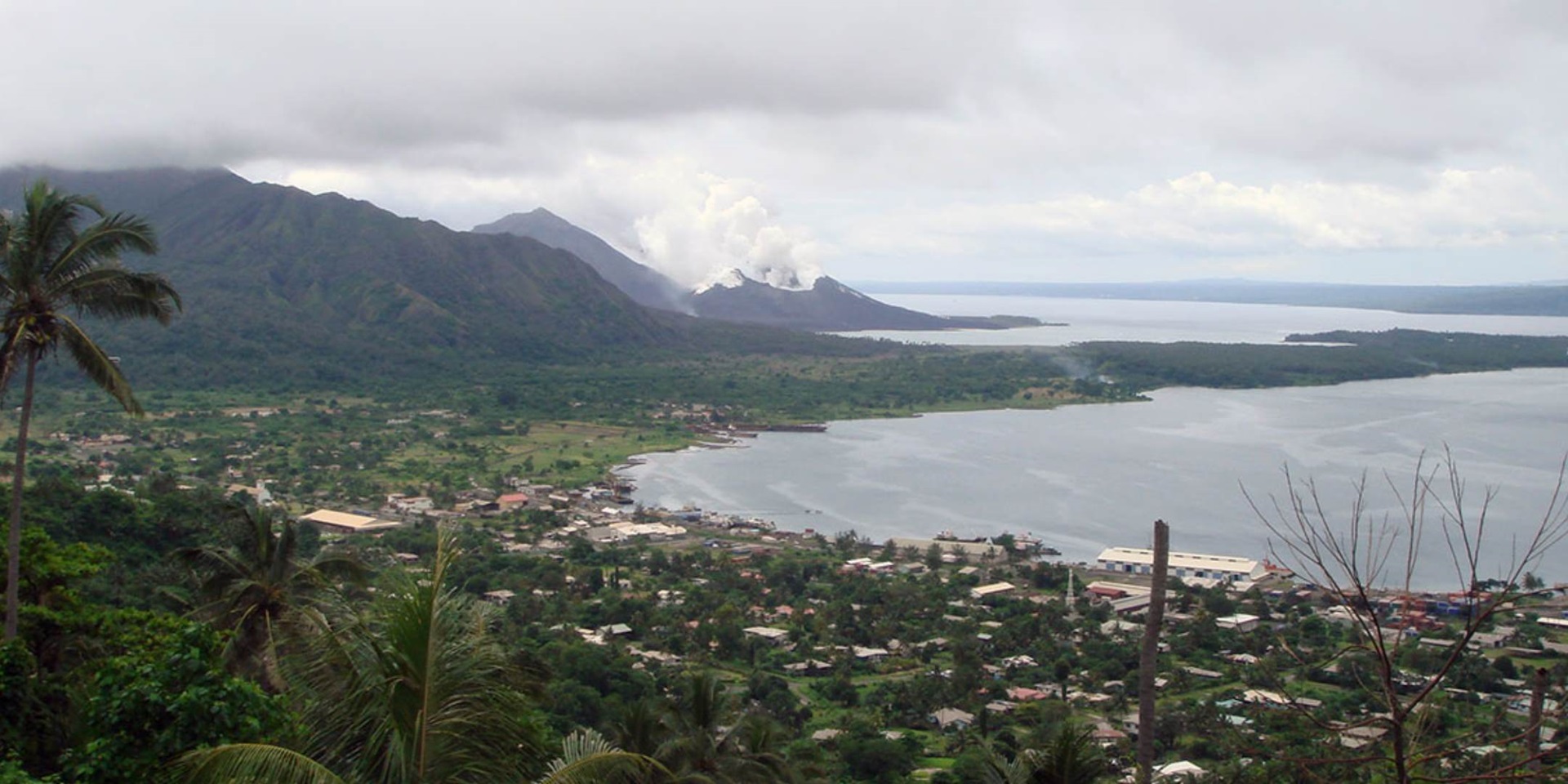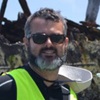
Early efforts to find AE1
Wartime expediency dictated that little effort was expended finding AE1 in the immediate wake of its loss, and for over 60 years the submarine and its crew were largely forgotten. Modern interest in finding AE1 had its origins with Commander John Foster (OAM), a Royal Australian Navy (RAN) officer acting as the Assistant Defence Attaché to Papua New Guinea in Port Moresby during the 1970s. Foster became intrigued by AE1’s disappearance, and conducted research at various Australian archives in an effort to identify the submarine’s most likely loss location.
Duke of York Islands in Papua New Guinea. Credit: NASA/Wikimedia Commons
By 1976, he had defined a promising search area, and obtained permission from the RAN to examine it with side-scan sonar deployed from the Hydrographic Survey ship HMAS Flinders. Ultimately, the survey proved unsuccessful due to the limited capability of Flinders’ side-scan sonar, although one contact of interest was identified near the Credner (modern-day Pidgeon) Islands. Two years later, Flinders conducted an ad hoc search while deployed to Papua New Guinea, but failed to detect any targets of interest. Undeterred, Foster continued to scour the archives during the 1980s, and visited Rabaul to speak with local residents and determine if references to AE1 existed in their oral histories.
Perhaps motivated by Foster’s research, renowned underwater explorer Jacques Cousteau searched for AE1 while transiting between the provinces of New Britain and New Ireland in 1990. Cousteau’s plan was to deploy a submersible from his research vessel Calypso and examine the sonar contact detected by HMAS Flinders near the Credner Islands in 1976. Unfortunately, the submersible was plagued by technical issues and the dive aborted. Cousteau’s crew instead conducted a magnetometer survey of the area, but failed to detect any contacts of interest.
In 2002, Foster obtained financial support from a film production company to search for AE1 in the nearshore waters off Mioko Island. The new search area was selected based on information shared by the parish priest at a local Catholic mission in the village of Milamila. According to the priest, the parish’s financial assistant and his brother claimed to have spotted a wrecked submarine while diving for shells on Mioko Island’s Wirian Reef. Scuba divers under Foster’s direction attempted to inspect the site, but were prevented from doing so by the presence of several large pelagic sharks.
Foster bankrolled another expedition at the beginning of 2003, and conducted diving operations from a utility boat owned by the Rabaul Hotel. Two local divers hired by Foster to search for the submarine encountered several sharks, but failed to locate any shipwrecks. Foster then secured funding from the Australian Broadcasting Company (ABC) and initiated a second search later the same year. Project participants included an ABC filmmaker and researchers affiliated with the Western Australian Maritime Museum and author Clive Cussler’s non-profit organisation the National Underwater and Marine Agency.
This time, the area of interest included shallow waters along the southern edge of Mioko Island, and adjacent Kerawara and Kabakon Islands. Unfortunately, the search failed to find any shipwreck sites of interest. During his 2003 visits Foster also first learned of the Tolai legend about the ‘devil fish’ (submarine) that approached Mioko Island on the day of AE1’s disappearance.
HMAS Benalla conducting a multi-beam sonar survey off Mioko Island, February 2007. Wirian Point is visible in the right background. Courtesy G.J. Mellon
Four years later, Foster obtained support from Australia’s Department of Defence and Department of Veterans’ Affairs to resume the search for AE1. RAN Hydrographic Survey vessel HMAS Benalla was tasked to survey waters adjacent to Mioko Island and detected an object of interest near Wirian Reef that correlated to local accounts of the submarine’s disappearance.
Unfortunately, Benalla’s magnetometer was rendered inoperable after it struck a submerged reef, and its sonar equipment proved unsuited to the task of positively identifying the contact.
During the latter half of 2007, a second expedition sponsored by the RAN deployed the minesweeper HMAS Yarra to conduct a search using variable depth sonar and a remotely-operated vehicle (ROV) outfitted with sonar and video. Tasked with inspecting the contact detected by Benalla earlier in the year, Yarra too was unable to positively identify it due to problems with equipment and personnel.
Although available sonar imagery bore strong resemblance to a section of submarine hull and conning tower, it was later identified as a geological formation following analysis at the RAN’s Seapower Centre and Defence Science and Technology Organisation (DSTO).
Commander John Foster (centre) disembarking from HMAS Benalla, 27 February 2007. Foster directed efforts to locate AE1 between the 1970s and his death in 2010. Courtesy G.J. Mellon
Obstacles to search and survey
The Seapower Centre and DSTO findings highlighted fundamental issues associated with any search for the missing Australian submarine. Naturally-occurring geological formations in the rugged seabed landscape around the Duke of York Islands occasionally create acoustic signatures that resemble ship- and submarine wrecks. Other challenges abound as well, including natural magnetic interference, seismic and volcanic activity, and extreme water depth.
Devices that operate according to variations in the earth’s magnetic field (such as magnetometers) can be disrupted by volcanic activity and result in ‘false positives’ that give the impression of a shipwreck. Volcanoes and earthquakes—a common occurrence in Papua New Guinea—can cause massive upheaval and change in the underwater landscape. In the worst cases, this may include avalanches and mass deposits of pyroclastic material that can completely bury a wreck site.
Rabaul and Simpson Harbour, as viewed from the seismic observatory on the rim of the caldera behind the town, February 2007. COURTESY G.J. MELLON
Water depth in the search area commonly exceeds 1000 metres, which precludes diving of any kind and limits the types of survey equipment and methods that can be used. Even if promising targets are located in deep water, few alternatives are available to allow researchers the opportunity to visually inspect and identify them. Only ROVs and submersibles designed specifically to operate at great depth can be used, and these devices are both exceedingly rare and expensive to operate.
One final, but frequently overlooked, obstacle exists to any successful search for AE1: the presence of other shipwrecks. Simpson Harbour and St. George’s Channel were sites of intense military activity during the Second World War, and several iron- and steel-hulled vessels were sunk as a result of combat, or post-war activities (such as scuttling or abandonment). As a consequence, several shipwrecks are located within the general area of AE1’s loss and may be detected by survey equipment. All of these potential AE1 candidates must therefore be identified and ruled out as they are encountered.
Recent expeditions
At the beginning of 2009, Foster organised yet another search for AE1. While in the process of planning the expedition, he conferred with former Rabaul-based salvage diver George Tyers, who claimed to have observed a wrecked submarine while working in Simpson Harbour in 1971. Tyers stated the submarine was in close proximity to a wrecked Japanese freighter, Keifuku Maru, and bore resemblance to archival photographs of AE1.
Armed with this information, Foster commenced searching the area in May 2009. The project was sponsored in part by the Seven Television Network, and footage of the search was later aired on Seven’s ‘Sunday Night’ program. A diver survey of the seabed at the location specified by Tyers failed to find evidence of a wrecked submarine or—curiously—Keifuku Maru.
Overlay of charts from 1963 and 1996, showing the location of Keifuku Maru (centre left) and its burial by expansion of the adjacent coastline due to volcanic activity. Courtesy Western Australian Maritime Museum
A second expedition in 2009 enlisted the assistance of researchers from the Western Australian Maritime Museum and Project Silent Anzac (responsible for locating and documenting AE1’s sister-submarine AE2) to conduct another search in Simpson Harbour. A magnetometer survey of the purported location of Keifuku Maru confirmed that the shipwreck was present, but no longer visible because it had been buried beneath 30 metres of pyroclastic rock generated by a major volcanic eruption at Rabaul in 1994. The wrecked submarine reported by Tyers was not located during this expedition and may have been buried by the same eruption that caused the ‘disappearance’ of Keifuku Maru.
While participating in military exercises (Operation Render Safe) in the vicinity of Rabaul, the Royal New Zealand Navy survey vessel HMNZS Resolution and Australian minesweeper HMAS Gascoyne detected an unusual sonar contact in Simpson Harbour. Subsequent inspection of the contact revealed it to be a previously unidentified Japanese midget submarine lost during the Second World War. Resolution later conducted a multi-beam sonar survey within the inshore section of AE1’s highest-probability loss area, but failed to find anything of note.
Side-scan sonar image of a portion of Wirian Reef, showing geological formation (lower left) with the appearance of a submarine. Courtesy Western Australian Maritime Museum
In September 2014, HMAS Yarra conducted its second search for AE1, this time in waters immediately to the east of Mioko Island. The vessel deployed side-scan sonar and conducted a systematic survey within an area covering approximately 13 square kilometres. While the 2014 survey grid covered an area encompassing AE1’s highest probable loss location, secondary and tertiary zones identified by project researchers amount to an additional 370 square kilometres that have yet to be searched. An ‘object of interest’ was located on the final day of the survey, but was ultimately identified as a geological formation.
Sadly, John Foster passed away in 2010, but his fellow researchers have continued his cause, actively looking for AE1 under the banner Find AE1 Ltd.
AE1 found in 2017
103 years after AE1 sank, the submarine’s final resting place was located off the coast of the Duke of York Islands in Papua New Guinea. The thirteenth search effort to find the submarine, conducted in December 2017, was successful. The expedition team was jointly funded by the Australian Government, the Silentworld Foundation, the Australian National Maritime Museum and Find AE1 Ltd; utilised Fugro Survey’s vessel and search technology.
Survey data showing HMAS AE1 on the sea bed.© Commonwealth of Australia via Royal Australian Navy.
Find AE1 survey team analysing the drop camera vision.Photographer: Bayden Findlay / © Commonwealth of Australia via Royal Australian Navy.
Modern contamination on the casing of HMAS AE1.Photographer: Bayden Findlay / © Commonwealth of Australia via Royal Australian Navy.
Broken casing of HMAS AE1.Photographer: Bayden Findlay / © Commonwealth of Australia via Royal Australian Navy.
The final location of the wreck of the AE1 was found in December 2017.
The Australian Government will work closely with the Papua New Guinean Government to consider a lasting commemoration and recognition of the crew of AE1 and to preserve the site. More information on the expedition can be found on the Royal Australian Navy website.
